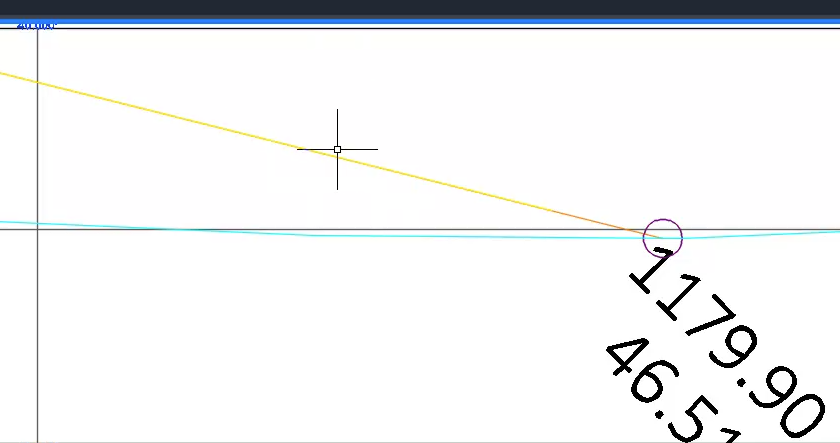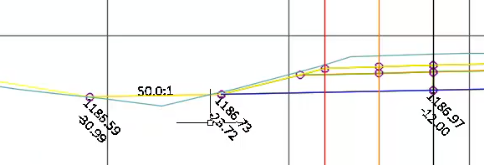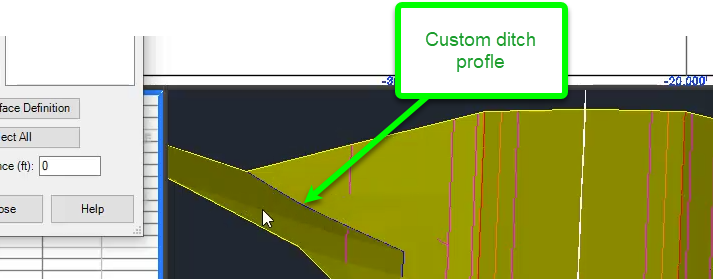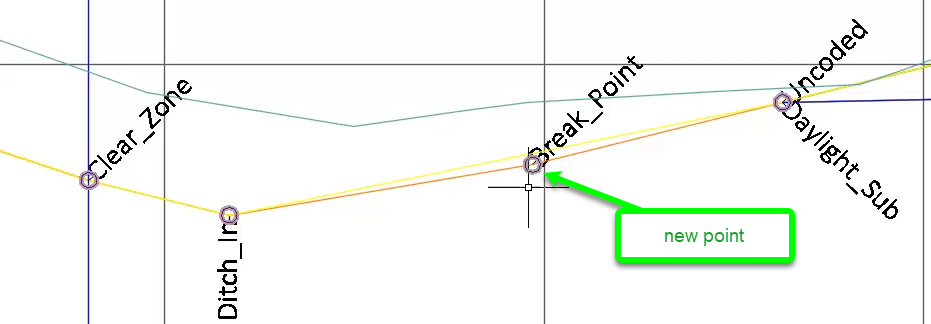DaylightProfileControlled workshop
Last updated: 2024-05-17
Total video time: 1:33:33
 Standards discussion and subassembly features
Standards discussion and subassembly features
crdr-ele-dalitpc-wrkshp-01.mp4 7:53
The flexibility of the DaylightProfileControlled (DaylightPC) subassembly allows a wide range of slope editing and slope configuration changes without having to change assemblies or regions. This workshop is focused on showing the capabilities of the subassembly, not on the practical implementations of it.
For instance, while it is completely possible to change a side slope from 6:1 to 2:5:1 over a distance of 25 FT, that doesn't mean it will meet standards or is easily constructable. Links can also be made that are very narrow. Generally speaking, slopes that can be constructed with an 8 FT wide bulldozer blade are what should be designed. However, modernization projects can have different requirements than perpetuation and rehabilitation projects.
All of this is to say, designers must be mindful of standards and constructability when designing side slopes and their transitions. Below are some of the FDM sections that discuss side slopes and ditches:
- FDM 11-15-1.11 Side Slopes
- FDM 11-15-1.12 Side Ditches
- FDM 11-15-1.13 Clear Zones, Horizontal Clearances, and Clear Roadway Widths of Bridges
- FDM 11-40-6 Design Standards for Perpetuation Projects
- FDM 11-40-7 Design Standards for Rehabilitation Projects
- FDM 11-45-20 Roadside Hazard Analysis
DaylightProfileControlled features
- Has multiple link logic
- Can control slope values by targeting control profiles
- Can force fill and ditch logic as needed
 Subassembly logic
Subassembly logic
crdr-ele-dalitpc-wrkshp-02.mp4 7:18
A daylight subassembly is built to intercept a surface. DaylightPC does that with a number of optional interior links.
Normally the sub's daylight link (final link) logic is determined by it's insertion elevation with regards to target surface (Exist)
- goes down if insertion is above Exist (fill logic)
-
goes up if insertion is below Exist (cut/ditch logic)
Warning: Depending on link slope values and existing ground, it is easy for any Daylight sub to NOT intercept existing ground. If nothing gets drawn on a section, check Panorama for error status.
Daylight subs typically cannot be forced to switch between fill and ditch logic. They will always go up if below Exist and down if above Exist.
Tip: DaylightPC can switch between fill and ditch logic. This means that no matter where the sub is inserted, it can have a positive (up) or negative (down) daylight link.
See Please see help on the web at DaylightProfileControlled for images of different slope situations and for full documentation of sub behavior.
Fill logic options (from outside to in)
-
1 down daylight link (fill slope)

-
OPTIONAL: 1 down link (recoverable slope (clear zone))

Ditch logic options (from outside to in)
- 1 up daylight link (ditch backslope)
- OPTIONAL: 1 up link (traversable ditch backslope)
- OPTIONAL: 1 flat link (flat-bottom ditch)
- OPTIONAL: 1 down link (ditch slope)
- OPTIONAL: 1 down link (connecting slope) used when ditch point elevation is managed by a ditch profile and the start of the ditch slope is beyond the recoverable foreslope.
- OPTIONAL: 1 down link (recoverable foreslope) used when ditch point elevation is managed by a ditch profile.
- AND Berm logic
- Berm logic kicks in if all the logic up to this point puts you above Exist and you need to go down to daylight. A flat link (berm width) and a down daylight link (fill slope) are inserted after ditch backslope


Multi-intercept options for both fill and ditch
Daylight link option for multi-intercept on both fill and ditch logic.
Multi-intercept can be controlled by:
- Minimum offset distance controlled by horizontal target Minimum offset to intercept
- Minimum offset distance controlled by control profile Minimum offset to intercept from profile
- Number of intercepts from control profile Number of target surface intercepts from profile
 Common input and target parameters
Common input and target parameters
crdr-ele-dalitpc-wrkshp-03.mp4 6:35
Warning: This is not a complete list of parameters for DaylightPC. Please refer to DaylightProfileControlled – Version 26.0 for full documentation.
Input parameters
| Input parameter | Usage |
|---|---|
| Set min offset >/= to clear zone or recoverable slope offset? |
If Yes, this parameter will force the sub to follow it's logic at least out to the clear zone offset and then attempt to daylight afterwards. If No and the sub finds a daylight intercept before the clear zone, it will daylight and stop. Functionally, if a project's scope is to ensure recoverable slopes out to the clear zone, setting this parameter to Yes will make sure grading happens at least that far out. If a project's scope requires daylighting as soon as possible, No will make that happen. |
Target parameters
| Target parameter | Usage |
|---|---|
| Ditch/Fill Switch |
Controls whether the sub follows ditch or fill logic
|
| Ditch backslope from profile and Fill slope from profile | The final slope of the sub in ditch and fill logic |
| Offset to measure recoverable slope from | The offset to start the clear zone measurement from. Typically this is the farthest out edge of travelled way. |
| Clear zone width from profile | The width where the slope breaks from the Recoverable value to the Ditch backslope or the Fill Slope. |
| Recoverable foreslope from profile | The recoverable slope. This is only in effect if the clear zone offset is greater than the insertion point of the subassembly. |
 Using Control Profile Editor and data setup
Using Control Profile Editor and data setup
crdr-ele-dalitpc-wrkshp-04.mp4 11:27
How to set up slope/width control profiles
-
Use Profile - Control Profile Editor
Tip: Many subassemblies in the WisDOT sub library use control profiles to target parameters not available for targeting in the default Civil 3D interface. Control profiles are just station-based "buckets" to hold and manage whatever parameter values you need. Slopes, widths, heights, and other parameters can all be controlled with control profiles and then targeted for easier manipulation of parameters.
All slopes are entered in decimal values. Common slopes and their decimal equivalents
Slope (run:rise) Decimal equivalent 10:1 0.1 6:1 0.167 4:1 0.25 3:1 0.33 2.5:1 0.4 - Add begin station with default value
- Add end station with default value
- Save the profile
-
Target the profile
How to use the slope/width control profiles #use-cntrl-prfl
When there is an edit to a default value to make
- Enter a station and default value for the end of the default and resuming the default
-
Enter a station and new value for the range of the change. This can be one station or many.
Here is an example of changing the default final slope for 200 FT
Station FinalSlp (Fill Slope, Ditch backslope) 20+00 0.25 20+50 0.4 22+50 0.4 23+00 0.25 Here is an example of forcing a fill for one station
Since this a logic switch and not a linear transition, the bounding stations of the default value are brought right next to the custom value station.
Station Ditch/Fill Switch 10+99 1.0 11+00 1.5 11+01 1.0
- XREFs
- Topo-Ex.dwg (unloaded)
- Surfaces
- Exist (DREF from Surf-Ex.dwg)
- Alignments
- Centerline (all DREF from AliProf-25.dwg)
- 25
- Lcl-4thAve
- Offset (all DREF from AliProf-25.dwg)
- 25-L-EGS
- 25-L-EPS
- 25-L-ETW
- 25-R-EGS
- 25-R-EPS
- 25-R-ETW
- Centerline (all DREF from AliProf-25.dwg)
- Profiles
- 25-Exist
- 25-Prop
- Assembly
- 25-Full Section
- Model views
- 3D-25-Crdr
- Top-25-Asmbly
- Top-25-Crdr
 Create control profiles and corridor
Create control profiles and corridor
crdr-ele-dalitpc-wrkshp-05.mp4 5:34
The following steps use a number of custom tools to quickly build and target the corridor, it's target parameters, and the resulting corridor surfaces.
The inputs for these tools can be customized for specific project needs. The defaults will not apply to every project scope.
All of these steps can be done manually and many will likely need to be at some point in a project.
- WisDOT Design tab > Design panel > Profile dropdown > Profile - Control Profile Editor
- Create tab
- Alignment: 25
- Multiple - Use WisDOT Default: checked
Create
Review control profiles created
- Create tab
- The assembly 25-Full Section has already been placed, renamed, labeled, and bookmarked with model view Top-25-Asmbly. The following steps
- WisDOT Design tab > Design Palettes panel > WisDOT Subassemblies
- INTERSECTION ASSEMBLIES tool palette > Rural Full Section Place assembly in modelspace
- Select assembly in modelspace > Contextual ribbon > Modify assembly panel > Assembly Properties
- Information tab
- Name: 25-Full Section
- OK
- Information tab
- WisDOT Design tab > Design panel > Assembly dropdown > Assembly - Label Assembly
- Press Enter to accept the current text size of 0.0700, or type new text size Enter
- For global labeling press [All] : For single labeling press <Enter> A Enter
- WisDOT Design tab > Design Palettes panel > WisDOT Subassemblies
- Home tab > Create Design panel > Corridor dropdown > Corridor
- Name: 25-DLPC
- Corridor style: RDWY Proposed
- Alignment and profile: selected
- Alignment: 25
- Profile: 25-Prop
- Assembly: 25-Full Section
- Target Surface: Exist
- Set baseline and region parameters: checked
- OK
- 25-DLPC Corridor Properties > Parameters tab
- Start Station: 398+25
- End Station: 402+00
- Frequency dialog
- Set all distances to 25
- Set all yes/no options to Yes
- OK
- OK No need to rebuild at this time.
 Assign corridor targets
Assign corridor targets
crdr-ele-dalitpc-wrkshp-06.mp4 7:23
- WisDOT Design tab > Design panel > Corridor dropdown > Corridor - Assign Corridor Targets
- Corridor: 25-DLPC
- Baseline: 25 - 25-Prop
- Region: 398+25 - 402+00
- Targets
- Assign: selected
File open CrdrTrgtAssgn-FullSection.csv Open
Tip: This file was pre-copied from C:\WisDOT\Stnd\C3D20XX\Components\Assemblies to the same folder as the corridor file to save time. You will need to do this on your own in production projects.
- Excel
- File Save As... C:\Civil 3D Projects\trn-dalitpc-wrkshp-c3d22\dsgn\crdr\CrdrTrgtAssgn-FullSection.csv
- Save
- File Save As... C:\Civil 3D Projects\trn-dalitpc-wrkshp-c3d22\dsgn\crdr\CrdrTrgtAssgn-FullSection.csv
- Assign > File Open C:\Civil 3D Projects\trn-dalitpc-wrkshp-c3d22\dsgn\crdr\CrdrTrgtAssgn-FullSection.csv
- OK Close
- Toolspace > Prospector > Corridors > Right-click 25-DLPC > Rebuild
 Create corridor surfaces, shrinkwrap surfaces
Create corridor surfaces, shrinkwrap surfaces
crdr-ele-dalitpc-wrkshp-07.mp4 3:19
- WisDOT Design tab > Design panel > Corridor dropdown > Corridor - Create Corridor Surfaces
- DOTCREATECORRIDORSURFACES Select Corridor Surface definition file [Default browse Current browse Last]:D Enter
- WisDOT Design tab > Design panel > Corridor dropdown > Corridor - Shrink Wrap Corridor Surface
- Surface: Crdr-25-DLPC-Datum
- Select By Surface Definition
- OK
- Surface: Crdr-25-DLPC-Top
- Select By Surface Definition
- OK
- Close
 Set up views for corridor editing
Set up views for corridor editing
crdr-ele-dalitpc-wrkshp-08.mp4 2:43
- Select 25-DLPC in modelspace > Contextual ribbon > Modify Corridor Sections panel > Section Editor
- Set up views to see Section Editor, plan view, and 3D view
- Plan view: Top-25-Crdr
- 3D view: 3D-25-Crdr
 Remove slope break by changing clear zone control profile
Remove slope break by changing clear zone control profile
crdr-ele-dalitpc-wrkshp-09.mp4 5:05
Notes
Info: Exercise steps found below
Get a single daylight link down
Fill logic only has 1 or 2 links.
To always only have one link:
- Input parameters
- Offset to measure recoverable slope from: set to design standard
- Clear zone distance: 0.0 FT
Reduced recoverable distance: 0.0 FT
If you have Offset to measure recoverable slope from set, you usually want 2 slopes, but you want 1 slope for some stations, there are 2 options:
- Target Recoverable slope from profile with a slope control profile and set the value the same as fill slope. This is the easiest method. It will still have a point at the Clear Zone, but that can be removed from cross sections with label control if necessary.
- To completely remove the recoverable slope link
- Create a Clear Zone horizontal target (alignment) at an offset that will eliminate the slope break (inside sub insertion). The recommendation here is to only create it for the length of need, not the entire roadway length.
- Target Clear Zone offset with the horizontal target
Get a single daylight link up
Ditch logic by default will create a single link down (ditch foreslope), and possibly 2 links up (traversable ditch backslope and ditch backslope). We need to zero out the ditch foreslope and traversable ditch backslope to get a single daylight link up.
Assuming we want ditch foreslope and traversable ditch backslope throughout most of the corridor region, we accomplish this through target parameters
- Create a slope/width control profiles for Ditch foreslope width from profile
- Create a horizontal target for Clear zone offset
- For the station to have a single daylight link
- Ditch foreslope width value: 0.0 FT
- Clear zone target object: inside sub insertion
Exercise steps to change some stations to have single slope instead of two slopes
- Section Editor > Select Station: 400+25
- Zoom to right side
- WisDOT Design tab > Design panel > Profile dropdown > Profile - Control Profile Editor > Edit tab
- Alignment: 25
- Control Profile: ZCP-25-R-CZWidth
Add the following values
Station Right CZ width 400+00 30 400+25 50 400+50 30
- To update the boundary, rerun WisDOT Design tab > Design panel > Corridor dropdown > Corridor - Shrink Wrap Corridor Surface
- Surface: Crdr-25-DLPC-Top
- Select By Surface Definition
- OK
Close

 Force fill logic
Force fill logic
crdr-ele-dalitpc-wrkshp-10.mp4 6:13
Force a fill slope (daylight slope that goes down) and match it to subgrade
- Target Ditch/Fill Switch with a control profile.
- Ditch/Fill Switch value: 1.5 (anything greater than 1 will force Fill)
- Make sure Recoverable foreslope from profile is targeted
-
Recoverable foreslope control profile value: 0.02
Exercise steps
- Section Editor > Select Station: 400+50
- Zoom to left side
- WisDOT Design tab > Design panel > Profile dropdown > Profile - Control Profile Editor > Edit tab
- Alignment: 25
- Control Profile: ZCP-25-L-DFS
Add the following values
Station Left Ditch/Fill Switch 400+49 1 400+50 1.5 400+51 1
Tip: A Ditch/Fill Switch does not have a linear transition, so the bracketing stations are very close
Close
-
Toolspace > Prospector > Corridors > Right-click 25-DLPC > Rebuild
- After this edit, we have forced fill, but the slope is too steep to intercept Exist. Next we'll flatten the slope.
- WisDOT Design tab > Design panel > Profile dropdown > Profile - Control Profile Editor > Edit tab
- Alignment: 25
- Control Profile: ZCP-25-L-RcvrFslp
Add the following values
Station Left Recoverable Foreslope 400+25 0.25 400+50 0.02 400+75 0.25
Close
-
Toolspace > Prospector > Corridors > Right-click 25-DLPC > Rebuild

- To update the boundary, rerun WisDOT Design tab > Design panel > Corridor dropdown > Corridor - Shrink Wrap Corridor Surface
- Surface: Crdr-25-DLPC-Top
- Select By Surface Definition
- OK
- Close
 Force ditch logic
Force ditch logic
crdr-ele-dalitpc-wrkshp-11.mp4 4:44
Notes
Force a ditch
- Target Ditch/Fill Switch with a control profile.
-
Ditch/Fill Switch value: 0.5 (anything less than 1 will force Ditch)
Forcing a ditch means that the insertion is above Exist surface, a ditch foreslope is being created, and the ditch backslope link is going up to intercept Exist surface.
If no surface is found, a berm is created and the intercept slope goes back down.
Target a custom ditch profile
Forced ditches are very situation-dependent, but some common things to do might be:
- Force ditch point below Exist surface
- Create custom ditch profile
- Target Ditch elevation with it
- Then flatten out backslope
- Create a slope control profile for Traversable ditch backslope from profile or Ditch backslope from profile
- Target the control profile
Slope control profile value: 0.1 or 0.05 or whatever!
Exercise steps
- Section Editor > Select Station: 398+75
- Zoom to left side
- WisDOT Design tab > Design panel > Profile dropdown > Profile - Control Profile Editor > Edit tab
- Alignment: 25
- Control Profile: ZCP-25-L-DFS
Add the following values
Station Left Ditch/Fill Switch 398+74 1 398+75 0.5 398+76 1
Tip: A Ditch/Fill Switch does not have a linear transition, so the bracketing stations are very close
-
Toolspace > Prospector > Corridors > Right-click 25-DLPC > Rebuild

Let's shorten up the non-recoverable slope while we're here
- WisDOT Design tab > Design panel > Profile dropdown > Profile - Control Profile Editor > Edit tab
- Alignment: 25
- Control Profile: ZCP-25-L-FinalSlp
Station Left Final Slope 398+50 0.333 398+75 0.4 (Enter 2.5: and it will convert) 399+00 0.25
Close
-
Toolspace > Prospector > Corridors > Right-click 25-DLPC > Rebuild

 Custom ditch profile
Custom ditch profile
crdr-ele-dalitpc-wrkshp-12.mp4 7:31
Create ditch profile
- Modelspace > Zoom into profile view
- Home tab > Design panel > Profile dropdown > Profile Creation Tools
- CREATEPROFILELAYOUT Select profile view to create profile: Click on profile view
- Create Profile - Draw New dialog
Name: <[Alignment Name]>-L-Dtch-1
Warning: You need to add a counter or location info in the name because you need a separate ditch profile object for each custom range. You cannot have a gap in profiles.
- Profile style: PROF Ditch Flow Line
- Profile label set: _No Labels
- OK
- Profile Layout Tools > PVI dropdown > Draw Tangents Click two points anywhere in the profile view
-
Profile Layout Tools > Profile Grid View
Station Elevation 400+75 1186.52 402+00 1184.00
Target ditch profile
- Toolspace > Prospector > Corridors > Right-click 25-DLPC > Properties...
- Parameters tab > Set Targets > DaylightProfileControlled-L > Ditch Elevation : 25-L-Dtch-1
- OK
- OK
- Rebuild corridor
- To update the boundary, rerun WisDOT Design tab > Design panel > Corridor dropdown > Corridor - Shrink Wrap Corridor Surface
- Surface: Crdr-25-DLPC-Top
- Select By Surface Definition
- OK
Close

 Adding missing point codes for surfaces for edited corridor
Adding missing point codes for surfaces for edited corridor
crdr-ele-dalitpc-wrkshp-13.mp4 4:07
Adding a ditch profile has added a point code that wasn't included in the creation of the Top corridor surface. This point needs to be added manually.
To see point codes in Section Editor
- Section Editor contextual ribbon > View Tools panel > View/Edit options
- View/Edit Corriodr Section Options dialog
- Code Set Style: CRDR Proposed - Point codes
- OK
-
OK

- View/Edit Corriodr Section Options dialog
Add point code to corridor surface
- Toolspace > Prospector > Corridors > Right-click 25-DLPC > Properties...
- Properties dialog > Surfaces tab > Crdr-25-DLPC-Top: Add data, Feature Lines, Break_Point
- OK
- Section Editor contextual ribbon > Close
 Flat bottom ditch
Flat bottom ditch
crdr-ele-dalitpc-wrkshp-14.mp4 4:54
- WisDOT Design tab > Design panel > Profile dropdown > Profile - Control Profile Editor > Edit tab
- Alignment: 25
- Control Profile: ZCP-25-L-DtchBtmWdth
-
Add the following values
Station Left Ditch Bottom Width 400+75 0 4010+00 8 401+75 0
-
Close
-
Toolspace > Prospector > Corridors > Right-click 25-DLPC > Rebuild

- Toolspace > Prospector > Corridors > Right-click 25-DLPC > Properties...
- Properties dialog > Surfaces tab > Crdr-25-DLPC-Top: Add data, Feature Lines, Ditch_Out
- OK
- Section Editor contextual ribbon > Close
- To update the boundary, rerun WisDOT Design tab > Design panel > Corridor dropdown > Corridor - Shrink Wrap Corridor Surface
- Surface: Crdr-25-DLPC-Top
- Select By Surface Definition
- OK
- Close
 Multi-intercept parameters, number of surface intercepts
Multi-intercept parameters, number of surface intercepts
crdr-ele-dalitpc-wrkshp-15.mp4 4:46
- WisDOT Design tab > Design panel > Profile dropdown > Profile - Control Profile Editor > Edit tab
- Alignment: 25
- Control Profile: ZCP-25-L-IntNum
-
Add the following values
Station Left Intercept Number 400+44 1 400+45 2 400+55 2 400+56 1
-
Close
- Toolspace > Prospector > Corridors > Right-click 25-DLPC > Properties...
- Parameters tab > Set Targets > DaylightProfileControlled-L > Number ot target surface intercepts : 25-L-Int-Num
- OK
- OK
- Rebuild corridor
 Multi-intercept parameters, minimum offset
Multi-intercept parameters, minimum offset
crdr-ele-dalitpc-wrkshp-16.mp4 3:26
- WisDOT Design tab > Design panel > Profile dropdown > Profile - Control Profile Editor > Edit tab
- Alignment: 25
- Control Profile: ZCP-25-L-MinOs
-
Add the following values
Station Left Minimum Offset 400+44 0 400+45 -55 400+55 -55 400+56 0
-
Close
- Toolspace > Prospector > Corridors > Right-click 25-DLPC > Properties...
- Parameters tab > Set Targets > DaylightProfileControlled-L > Minimum offset from profile : 25-L-MinOs
- OK
- OK
- Rebuild corridor
- Section Editor contextual ribbon > Close
- To update the boundary, rerun WisDOT Design tab > Design panel > Corridor dropdown > Corridor - Shrink Wrap Corridor Surface
- Surface: Crdr-25-DLPC-Top
- Select By Surface Definition
- OK
- Close